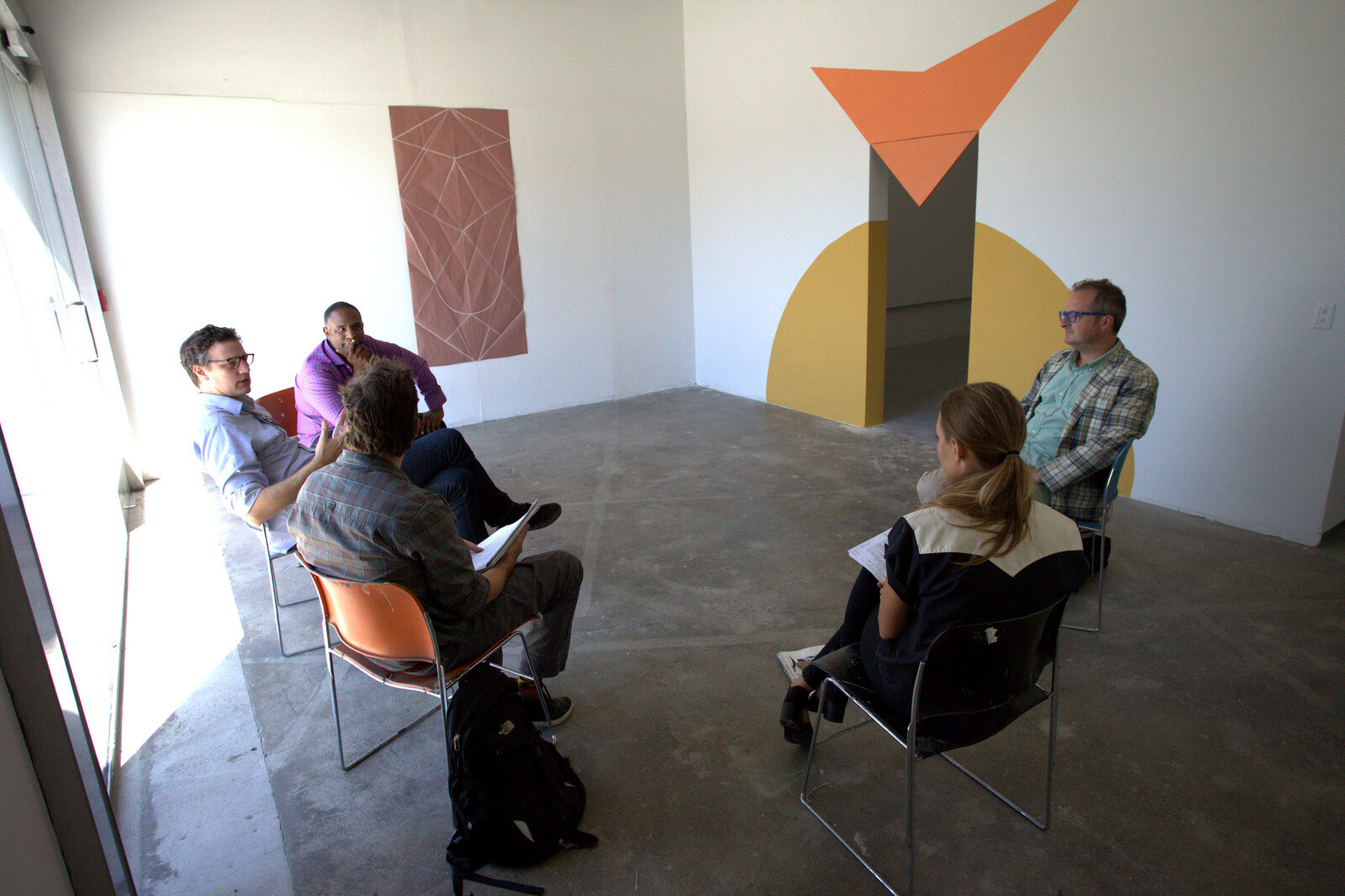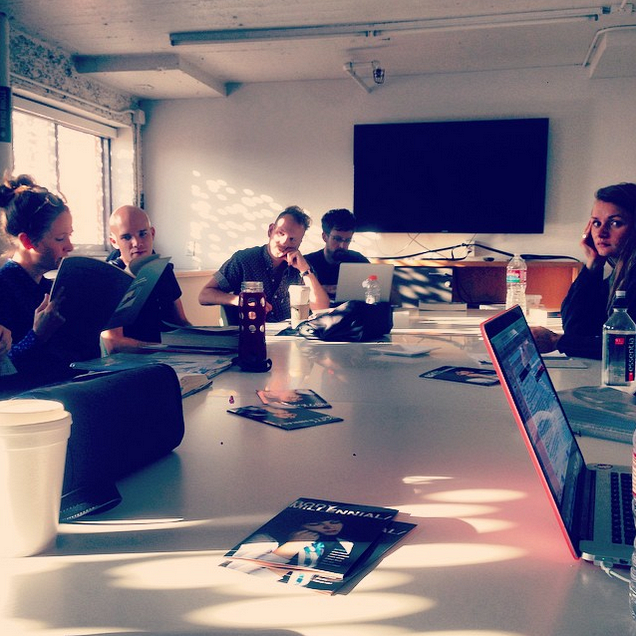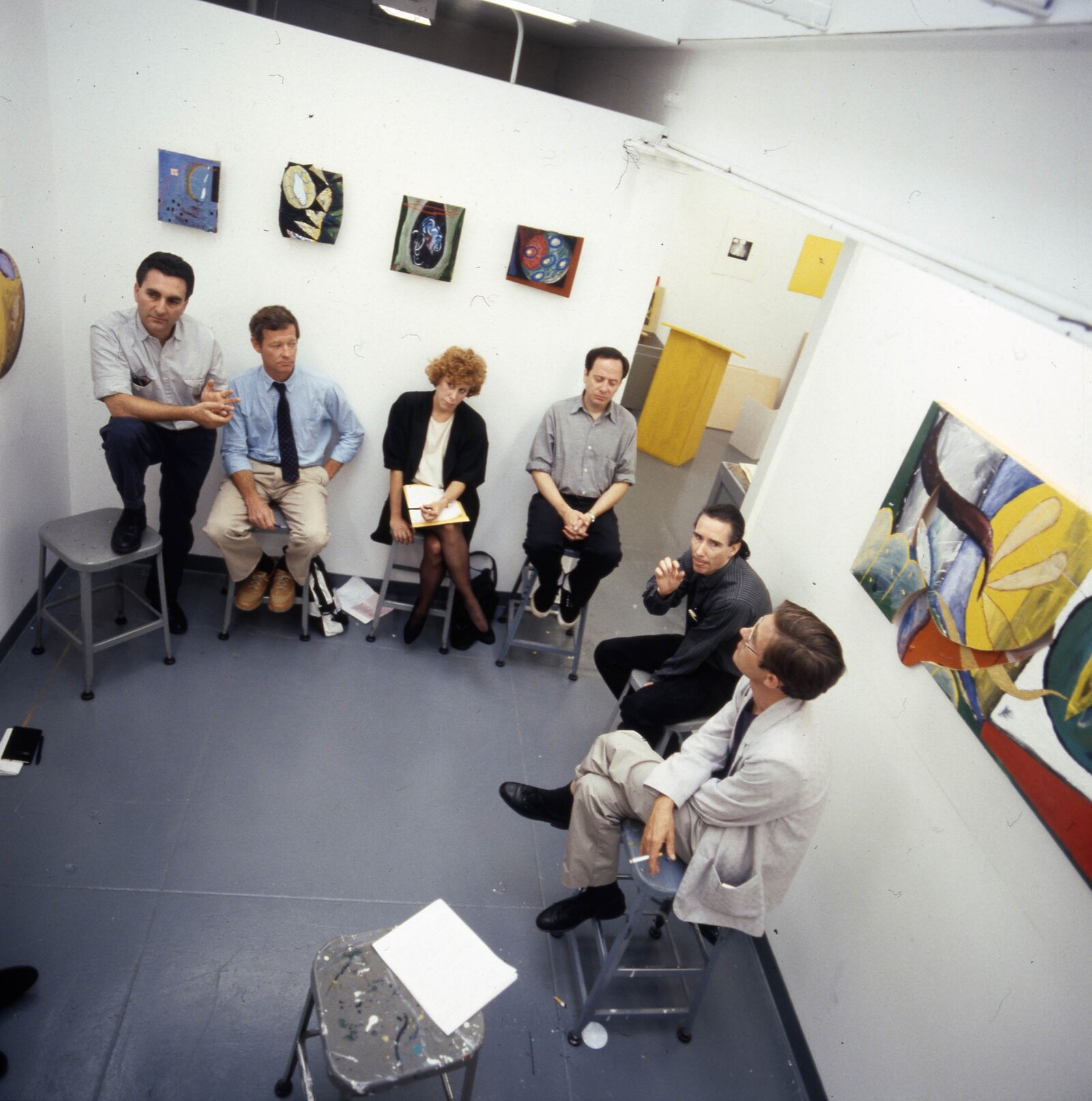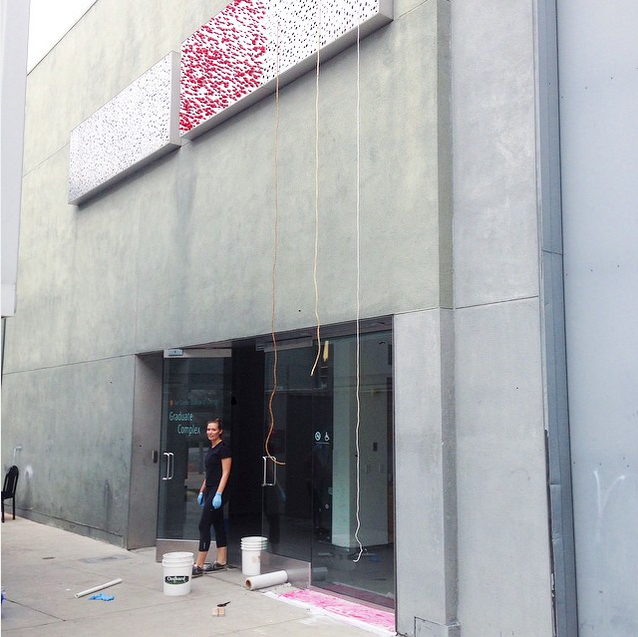http://www.artcenter.edu
ArtCenter College of Design / Facebook / Twitter / Instagram
In Los Angeles, you’re always getting off freeways. The 110 disgorges onto South Arroyo Parkway, and there to the left is the South Campus of the Art Center College of Design in Pasadena. Better known for the flowers and football of its Rose Parade/Bowl than anything else, the suburban city of Pasadena is a wealthy enclave with double the average household income of Los Angeles, just a few miles down the road. Getting to Art Center from the parkway takes just a few swift turns: pass the old power plant, the last industrial vestiges of an almost fully gentrified town, then take your first left on Glenarm, go over the Gold Line tracks, and pass an office tower bearing the name Parsons. Though not named for him, to me it’s an unlikely monument to the legendary local rocket scientist and Thelemite occultist Jack Parsons, a necessary shadow to all this bright suburban wealth. Make your first right on Raymond and you’ll find yourself in front of a converted aircraft design and testing facility, redesigned for Art Center with perforated metal flourishes by architects Daly Genik.
Opened in 2004 and housing the Graduate Art program, along with the Graduate Media Design Practices program and the Archetype Press letterpress printing facility, the South Campus inaugurated a new era for the college, establishing itself in the city seven miles from its bucolic and iconic 1974 “bridge building” designed by Craig Elwood up in the hills surrounded by grand manses. The brainchild of former MOCA director Richard Koshalek, the South Campus was just one part of an ambitious building scheme he began after the college hired him as president in 1998. But outsized ambitions sunk him: Koshalek was pushed out in 2008, with detractors stating that he was devoting too much attention to his own legacy of buildings and not enough money to instruction.
A technical design college, at Art Center fine arts were more of an afterthought; indeed, the school was sometimes jokingly called the “Design Center College of Design.” When Richard Hertz came on as director of the then Liberal Arts department in 1979, he created over his twenty-three-year tenure the graduate programs in digital media, graphic design, industrial design, film, and fine arts. Coming from the California Institute of the Arts (CalArts), Hertz designed a graduate art program inspired by the innovative model used up in Valencia, hiring many of its graduates to teach, including Mike Kelley, Christopher Williams, and Stephen Prina. Officially established in 1986, Art Center’s grad art program had, by the mid-nineties, become one of the most important in the country.
With varying versions, Southern California has developed an art-school model oft-copied for its success in moving students into careers as internationally exhibiting artists. Magazine writers periodically remark on the special situation of the region’s art schools, beginning perhaps with Ralph Rugoff’s essay “Liberal Arts” (on CalArts) published in Vogue in 1989, then Dennis Cooper’s “Too Cool for School” (about UCLA) published in Spin in 1997, and Andrew Hultkrans’s article in the summer 1998 issue of Artforum. These pieces were written during a moment when Los Angeles was still a relatively small scene, when the breathy excitement surrounding the graduates of SoCal art schools huffed and puffed into existence an industry all its own. In the developing of a diverse ecology for art in Southern California, art schools have played a fundamental role. The scene they created has grown dramatically, placing the schools in an increasingly junior position, one that diminishes their force and necessity. Because of their steep costs, this situation poses existential questions about the continued perceived necessity of an MFA.
In the Hultkrans article, the many interviewees, including numerous students, create a self-consciously false dichotomy between UCLA and Art Center, the latter emphasizing production and intuition, the former oriented more toward critical theory. The grad art faculty at Art Center during this time included Prina, Williams, and Kelley along with Jorge Pardo (Art Center BFA ’88), Diana Thater (Art Center MFA ’90), and Semitotext(e) founder Sylvère Lotringer. With a few notable exceptions, including Thater at Art Center, the faculty at both schools has largely moved on, and whilst the educational philosophy at UCLA is very different from its nineties heyday, Art Center is currently renewing the model of art education that initially brought the program to prominence.
Hertz left the school in 2002. After a brief acting chairmanship by artist Stephen Prina, who split in 2004 to accept a position at Harvard, the position of graduate chair was taken up by the brilliant, pugnacious writer and painter Jeremy Gilbert-Rolfe (“when people look at my paintings I’d appreciate it if they’d recall that they are made by the person who has demonstrated not only ostensively but also in prose that the death of painting is a crock of shit,” The Brooklyn Rail, May 1, 2005).
Either because of the institutional turmoil during Koshalek’s tenure or the idiosyncratic chairmanship of Gilbert-Rolfe, the Art Center Graduate Art program went rather quiet over the past decade. The more ambitious students headed to the generous financial assistance and increasingly famous faculty at USC (which recently imploded, with the first-year MFA students announcing their collective withdrawal in a letter announcing their collective withdrawal in these pages a month ago). New hires under Gilbert-Rolfe were firmly in the tradition of high theory and criticality, including artists Walead Beshty and Stan Douglas, as well as theorist Jason E. Smith.
The South Campus looks like what a design college would make for visual artists. Lacking the rough charm of UCLA’s Warner Building in the industrial Hayden Tract in Culver City, or the messy summer camp vibe of CalArts, the building looks clean and rather humorless, with many of the problems of a certain strain of modernist architecture: a spare, shadeless concrete plaza made more for admiring the building than for humans to actually gather comfortably. Inside, the studios and facilities are generous, even if the antiseptic feeling is still hard to shake, though some of the students are doing their best to fuck it up in ways that art students should.
Newly appointed Department Chair Diana Thater and Associate Chair Jason Smith welcomed me generously in their South Campus offices and emphasized a renewal of the school based on a recommitment to the approach that led to Art Center’s reputation as an art grad school: an emphasis on practice happening within a context of theory, or as MFA student Andrea Huber put it to me in an email, “I chose Art Center because it values academic discourse equally with studio practice.” They’ve begun to reach out to the extensive and talented network of Art Center graduates to re-engage them in the school. This includes some of the most important artists to emerge out of Southern California in the nineties and 2000s, such as Sharon Lockhart, Frances Stark, Sterling Ruby, and many others too numerous to list. Further, they posit a turn toward the larger community of Los Angeles, one that prepares artists for social and professional life outside the studio. To this end, they’ve recruited Laura Owens to the adjunct faculty. Owens taught many classes at her studio complex that includes the innovative art space 356 Mission, co-run by the artist with Wendy Yao and Gavin Brown. They’ve also added classes that visit and discuss exhibitions taking place around the city.
All the current students I spoke to were very happy with the renewed sense of purpose, and all of them were thrilled about the amount of attention they get. Every Wednesday, they meet with faculty for four to six hours. Core faculty members include Diana Thater, Jason Smith, Patti Podesta, Stan Douglas, Lita Albuquerque, Gabrielle Jennings, Bruce Hainley, Tim Martin, and Annette Weisser, along with adjunct faculty and guests who do studio visits every term with two visiting critics. Slated for next term are MOCA Chief Curator Helen Molesworth and Hammer Museum Assistant Curator Jamillah James. Out of the core faculty, the students I spoke to all cited the support and particular genius of writer and Artforum contributing editor Bruce Hainley, whose course descriptions are among the brightest and least institutional I’ve read. (From his class Beware of a Holy Whore [AGA-586]: “Since it may be the holiest and most whorish of whores to beware of, so-called ‘critique’ here becomes a cautionary tale.”
A Few Notes on Art Schools in Southern California
Art Center’s graduate art program feels like a school that is moving in an excellent direction, run by incredibly committed people. But it doesn’t exist in a vacuum, and it feels like it might be important here to give some context.
The graduate program at University of Southern California smolders, a collapse that made everyone become temporarily existential (including even the middlebrow New Yorker) about graduate art education, a thing not seen as necessary until fairly recently. The USC graduate students’ primary reason for leaving was that—as they alleged with copious evidence—the administration reneged on financial promises made to them. If the students had continued in the program with their revised financial package, they would have graduated with substantially more debt than they had signed up for. However this conflict susses out, one assumes a court will get involved, the debt of graduate art education being very real and very punishing. Schools, and by proxy the elder artists and art professionals that staff them, are asking students to mortgage their futures on the elusive potential of success (with some faculty becoming increasingly uncomfortable with this request).
So, do we even need graduate art schools?
Primarily used in the past to prepare artists to become teachers, graduate art schools now exist as a form of apprenticeship, a halfway house between undergraduate education and the real world. Less a ticket that guarantees a ride, they’ve become more a pass to enter into the marketplace (if you make it that far). To artists for whom money matters, graduate school is an experience that either the brave or the foolhardy take a chance on. But many aspiring artists feel they have to take that chance if they are ever to be taken seriously.
Here are the numbers. The Art Center graduate program costs $20,716 per term in tuition and fees. The Master of Fine Arts requires six terms, typically over three years. Though tuition fees tend to go up every year, at current rates an MFA from Art Center has the sticker price of $124,296. The program offers support to most students, but even for the top students this maxes out at half-scholarship, meaning a student with the best package would still graduate with $62,148 in debt (these numbers do not include living expenses, which add quite a bit to the loan amount though which can be alleviated with teaching assistantships). This is debt that will go up each year in accrued interest, and that the students can never discharge through bankruptcy. This is not to pick on Art Center, one of many schools in this predicament, with faculty who are wholly committed and care about their students. Though tuition is lower at public universities in Southern California (UCLA, for example, had a sticker price of $31,244 in 2013–14 for its two-year MFA), the debt load is still real, as are the strain and limitations it puts on students and potential students who are trying to become artists. As important as art school (and the impetus of its debt) has been to becoming an established artist in Southern California, historically, the schools themselves were fundamental in shaping the art community here, until perhaps now.
Let’s step back for a brief history lesson. With a miniscule art market and minimal institutional support, Los Angeles in the seventies was at best a place to study and then split. Students at the first internationally significant art school in the region, CalArts, usually cut and ran to New York upon graduation (one crew from the seventies became particularly famous, and their story is well-documented in Richard Hertz’s Jack Goldstein and the CalArts Mafia). Sometime in the eighties, the CalArts model—originally premised on permissiveness—became contentiously political, especially after the appointment of Catherine Lord to dean of the school. This move ended an era of freewheeling conceptualism and split the program, prompting the push-out of Gilbert-Rolfe (who landed at Art Center) and the resignation of John Baldessari.
Over at UCLA, a crackerjack group of artists was slowly being assembled. It came to include Paul McCarthy, Charles Ray, Lari Pittman, Barbara Kruger, and John Baldessari (who joined the faculty after his CalArts resignation). Dennis Cooper, in his piece for Spin, declared: “If UCLA were a rock scene, it would be Seattle, right after Nevermind went platinum.”
With each graduating class let loose into the city from these various programs, schools began to shape how the art community structured itself, creating networks of support and identification. A cluster of graduates would rehab a warehouse into studios; charismatic faculty members would continue to exert influence over their students either directly or indirectly; some students would drop out, open galleries, and then put on shows of work by their graduated peers. A scene slowly grew.
After years of development, Los Angeles, all grown up, perhaps no longer needs to rely on art schools to create networks of support or bring in outside talent. The major museums have developed their own decently robust systems of support—LACMA primarily through acquisition, and the Hammer Museum through its Made in LA biennial which mainly shows work made in Southern California, with an emphasis on emerging artists. (MOCA, which once had an exhibition program for emerging artists called Focus, is still on the ropes in this regard after years of instability.) The commercial gallery scene gets more robust with each passing month, from youngish upstarts to old stalwarts forming serious local satellites. The result is an alternative scene that exists without governmental support and is thus protean and generally ephemeral, but ever lively. There’s a thriving community here, and it doesn’t necessarily need schools to seed it anymore. Although USC’s grad art program has collapsed, hemorrhaging faculty and students, all of the people that made it a great school are still here, still members of a community—none to my knowledge have quit the city. And many people, attracted to all this activity, just move here.
Even if one school has lost its standing, the others remain, persisting in their efforts to educate artists in the best way they know how—though all, including the cheaper UCLA, still do so at rates that mortgage the future of their students. One Los Angeles artist I know just left the US to study in Germany, where her degree will cost something like 150 euros a year, with numerous opportunities for support.
The students I met with at Art Center, all very serious and talented, felt that they needed the space and time of an MFA to be taken seriously, as well as to take themselves seriously. They believed an MFA would help them enter the art world, which some of them perceived, as Andrea Huber put it, as “an unwelcoming, exclusive, hostile place,” adding “I wish it weren’t.” The debt load of an art school grad perhaps induces production and careerism when entering the commercial art market. But overall, the incredible programs that art school’s like Art Center manage to organize do come with a price, one that is deeply troubling.
Seriously dealing with these costs, or making them less necessary to becoming an exhibiting artist, shouldn’t diminish any of the schools’ excellence. The considerable expense—and corresponding debt—of all postsecondary education in America is being seriously questioned, though the possibility of a governmental solution seems bleak at best.
I’ll give the final word to the late, great critic, artist, and gallerist of China Art Objects, Giovanni Intra, who left his native New Zealand to attend Art Center on a Fulbright in 1996 and stayed on in LA afterwards, until his early death in 2002. Writing in 2000 for the exhibition “Circles” at ZKM in Karlsruhe—the entirety of his text is brilliant and I wish I could republish the whole thing here—Intra gives a prognosis that still reads entirely true fifteen years later, but which, under the current conditions, I hope is changing:
“The traditional—i.e. anti-institutional—notion of the alternative space, which abstained from financial dealing, had become redundant … disoriented by LA’s post-graduate school environment from which professionally enthusiastic twenty-eight-year-olds emerged from a boot-camp-like education with eighty thousand dollars in student debt. The graduate schools in LA were incredible environments, intellectually speaking, with brilliant students and teachers; underneath this was a layer of pure financial terror … Selling art is a lot of fun. To make money from art is a kind of revenge against the expense of graduate education and the political imperative which suggests that it is compulsory for young artists to attend school for extended periods and go into debt. The frequent outcome of this North American regime, which admittedly allows for some exceptions, is that only the financially privileged graduates can manage to enter the exhibition domain, which is certainly unfortunate as it is universal.”
—Andrew Berardini







